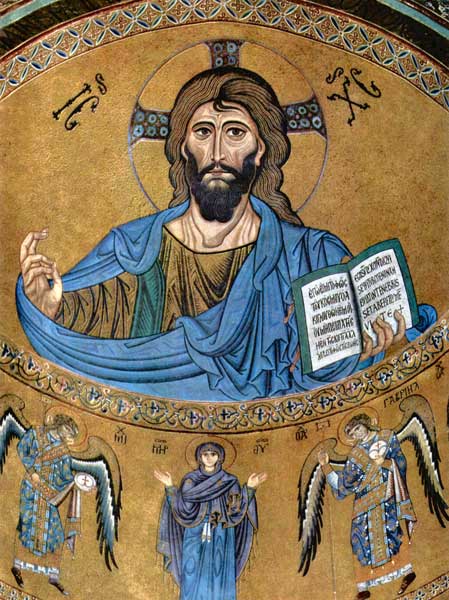Great Works: Christ Pantocrator (circa 1150), Anon
Cefalu Cathedral, Sicily

Your support helps us to tell the story
From reproductive rights to climate change to Big Tech, The Independent is on the ground when the story is developing. Whether it's investigating the financials of Elon Musk's pro-Trump PAC or producing our latest documentary, 'The A Word', which shines a light on the American women fighting for reproductive rights, we know how important it is to parse out the facts from the messaging.
At such a critical moment in US history, we need reporters on the ground. Your donation allows us to keep sending journalists to speak to both sides of the story.
The Independent is trusted by Americans across the entire political spectrum. And unlike many other quality news outlets, we choose not to lock Americans out of our reporting and analysis with paywalls. We believe quality journalism should be available to everyone, paid for by those who can afford it.
Your support makes all the difference.Now who is this? "The hallway smelt of boiled cabbage and old rag mats. At one end of it a coloured poster, too large for indoor display, had been tacked to the wall. It depicted simply an enormous face, more than a metre wide: the face of a man about 45, with a heavy black moustache and ruggedly handsome features."
Unmistakable, no? Read on, and you'll find he's inescapable. "On each landing, opposite the lift shaft, the poster with the enormous face gazed from the wall. It was one of those pictures which are so contrived that the eyes follow you about when you move. BIG BROTHER IS WATCHING YOU, the caption beneath it ran." 1984, page 1.
That's about all that George Orwell tells us about Big Brother's face. Still, in one way or another, the various filmings of the book manage to get this face wrong. The 1954 television version offers a bluff military type. The 1956 film has the mugshot of a powerful and clean-shaven criminal. In the 1984 film, Big Brother is a puffy and enraged Oswald Mosley in very close-up. All implausible.
It's pretty obvious that he should look like Stalin, as Stalin appears in propaganda portraits: noble, fatherly, stern. A strong face, yes – but not menacing or mad. Granted, no description and no visualization will really do the trick, because it won't convey the feelings invested in this face by people who live under it. The main thing is, it shouldn't be given too much particularity.
This face has functions deeper than character. The Party might have done without a face at all. There could have been an invisible and anonymous Big Brother who simply watched unseen. But it is better if the Party is personified, if Big Brother has a face. It makes a focus for loyalty and trust and obedience.
It is a face, face-on, and its eyes look straight out. These are the eyes that are "WATCHING YOU". But it is more than a gaze of surveillance, policing your every move. It watches over you, a guardian. It is also a gaze that gazes into your eyes, and a face that faces you. It involves you in a relationship of command and care.
This face is only a face. The poster (the book implies) shows no neck or shoulders. It is perhaps cut out like a mask. Big Brother has nothing so vulnerable as a body. Though intended as in some sense a real person, he lacks this feature of mortality. He is detached from any particular location. He is a presence, all-seeing, nowhere and everywhere. He is rather like God.
Orwell was strongly opposed to Christianity, but 1984 is directly an attack on the Communist Party, and only obliquely on the tyrannies of the Christian Church. The Big Brother poster, though, can be related to all kinds of imagery: Communist propaganda, militarist propaganda (like the Kitchener recruiting poster), Hollywood star-promotion, Christian icons. All of these images mobilize the power of the face. They use the human face to lock in to and overawe an intended public.
Take the image of Christ Pantocrator, Christ All-Powerful, a speciality of Byzantine art. There is, for example, the great mosaic, huge and high and gold-filled, in the central apse of Cefalu Cathedral. It is in a sense a likeness of Christ. It follows the established rules for what Christ looked like. It provides a figure on which the believers can fix their faith. But more than that, it presents a face, focused in a circular halo, a face face-on.
Unlike Big Brother, Christ Pantocrator has shoulders and hands. His left hand holds up the New Testament, with the words "I am the light of the world" legible. The right is held up in a gesture of blessing or teaching. It is essentially a speaking body we see, far from the solid, suffering body of the Crucifixion.
Nor are this Christ's eyes quite arranged like Big Brother's, to "follow you about when you move". That effect requires both pupils to be set dead centre. Christ's left eye is like that. The right is turned in a little. This disparity, if deliberate, has various interpretations.
But this image entrusts the divine all-power of Christ to the power of the frontal human face – and no surprise, either, that politics, armies, advertisers, religion, should all resort to it. The frontal human face, preferably enormous, is the most psychically charged physical object that we know.
Join our commenting forum
Join thought-provoking conversations, follow other Independent readers and see their replies
Comments